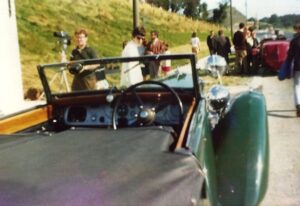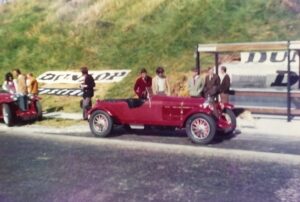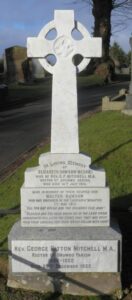History Hub Ulster Chair Gavin Bamford asks “How often do you go back and look at your old photograph albums and perhaps discover local history at your fingertips? Is there an archive of life in Northern Ireland waiting to be unveiled to future generations? Will they bring back memories to our older generations?”
Gavin recently found a small number of historical photos in an album from 1971 linked to the Ulster ’71 Festival organised by the Government of Northern Ireland to celebrate 50 years of Northern Ireland.
In 2021 when Northern Ireland celebrates its centenary many people are discussing the political aspects of the past century.
 The history of Northern Ireland isn’t always about politics; it’s about people and sporting achievements too. Between 1928 and 1936 the RAC (Royal Automobile Club) ran the Ards Tourist Trophy (TT) motor races over a triangular circuit of Dundonald, Newtownards and Comber.
The history of Northern Ireland isn’t always about politics; it’s about people and sporting achievements too. Between 1928 and 1936 the RAC (Royal Automobile Club) ran the Ards Tourist Trophy (TT) motor races over a triangular circuit of Dundonald, Newtownards and Comber.
On 11th September 1971 as part of the Ulster ’71 Festival the Ulster Vintage Car Club (UVCC) organised an event to commemorate the running of the Ards TT in the 20s/30s. This considerable project involved the erection of a brick ‘pit building’ together with a number of wooden ‘pits’ alongside it.
 Gavin’s photographs, a few are shown here, feature in a short video uploaded to the History Hub Ulster YouTube channel show the ‘pit buildings’ together with some of the wonderful vintage cars shown on the day.
Gavin’s photographs, a few are shown here, feature in a short video uploaded to the History Hub Ulster YouTube channel show the ‘pit buildings’ together with some of the wonderful vintage cars shown on the day.
The ‘Belfast Telegraph’ published the following article the day before the event:
LORD GREY’S LAP OF HONOUR
The Governor, Lord Grey will head a cavalcade of vintage sports cars round the 13.7 miles of the former Ards Tourist Trophy circuit to-morrow after opening a memorial to the TT races which used the circuit from 1928-1936.
 The memorial is in the form of a reconstruction of three of the pit ‘units’. These have been erected on the site of the original pits, close to the Rolls Royce factory outside Dundonald. Built of wood, the 10ft long structures were used by pit staff during races.
The memorial is in the form of a reconstruction of three of the pit ‘units’. These have been erected on the site of the original pits, close to the Rolls Royce factory outside Dundonald. Built of wood, the 10ft long structures were used by pit staff during races.
The memorial was undertaken by the Ulster Tourist Trophy Commemorative Committee, who scheduled it for Ulster 71.
Committee member, Mr. William Galbraith, said: “This is not just going to be a static out-of-reach memorial. The site of the pit ‘units’ will be a picnic area and a lay-by and we hope many people will use and enjoy it”.
Also on the site will be a brick-built store for the Ulster Vintage Car Club.
During Lord Grey’s tour of the circuit, it is hoped about 25 sports cars of the period, including several former TT cars will take part.
Said Mr. Galbraith: “Among the cars we are hoping to see is the 4-litre Lagonda, which won at Le Mans in 1935, and then took part here the same year, when driven by J S Hindmarsh”.
Mr. Galbraith said: “There will be three locally-owned ex-TT cars. One is Lord O’Neill’s Invicta which he will use to take Lord Grey round the course. Another is an Alfa Romeo, owned by Malcolm Templeton of Ballymena which will be driven by Jimmy Greenwood, who was the travelling mechanic to Bobby Baird in the 1933 race. The third car is an Aston Martin owned by Bob Stewart from Newtownards”.
Gavin comments “Although now on an extremely busy road, the lay-by and a ‘pit building’ is still there. The original ‘pits’ were destroyed by vandals over the past 50 years. The UVCC has installed a marble and slate commemoration stone at the location. Unfortunately, picnicking is definitely not recommended”.

 Archibald McIlroy of Drumbo was a stockbroker and Justice of the Peace who had emigrated to Canada with his wife to work as missionaries. Archibald was a published author in the Kailyard style, late 19th-century movement in Scottish and Ulster Scots writing that was characterised by a sentimental idealisation of humble village life. His novels captured the ethos of rural life, particularly from a Presbyterian perspective. Among his novels were When Lint was in the Bell, The Auld Meetin’ Hoose Green (1898), The Banker’s Love Story. Archibald and Anna McIlroy sailed in Second Class and Archibald, who was 55 years old, is commemorated on the war memorial tablet in Ballycairn Presbyterian Church, Ballylesson. Anna Caroline McIlroy died in Toronto on 21st July 1942 at the age of 77.
Archibald McIlroy of Drumbo was a stockbroker and Justice of the Peace who had emigrated to Canada with his wife to work as missionaries. Archibald was a published author in the Kailyard style, late 19th-century movement in Scottish and Ulster Scots writing that was characterised by a sentimental idealisation of humble village life. His novels captured the ethos of rural life, particularly from a Presbyterian perspective. Among his novels were When Lint was in the Bell, The Auld Meetin’ Hoose Green (1898), The Banker’s Love Story. Archibald and Anna McIlroy sailed in Second Class and Archibald, who was 55 years old, is commemorated on the war memorial tablet in Ballycairn Presbyterian Church, Ballylesson. Anna Caroline McIlroy died in Toronto on 21st July 1942 at the age of 77.
 A Typist
A Typist A Photographer
A Photographer